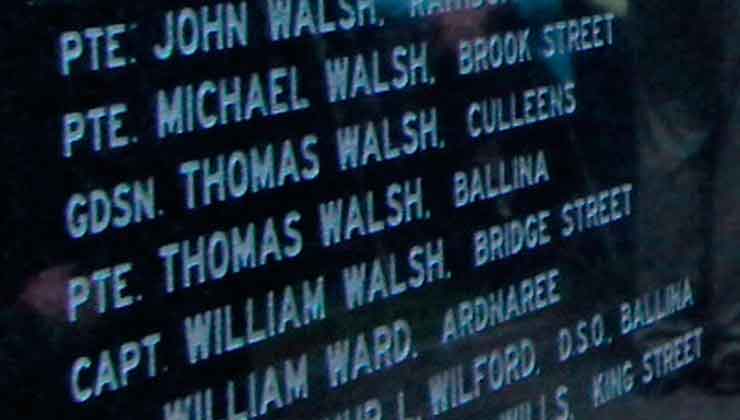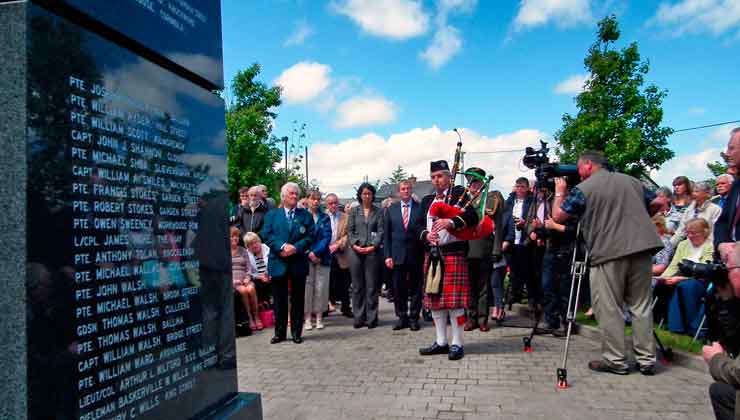As we approach the centenary Armistice Day commemoration here in Ballina, I am glad to report by the strangest of coincidences that we can shine some light on the fate of one of those young men whose name is inscribed on the Great War Remembrance Monument at Green Park, Ballina.
Private Thomas Walsh, a native of Ballina, who died on the Western Front in 1915 is still remembered in Norwich where there was a recreation of his funeral mass in early September.
This has come to light through the strangest of coincidences which I will now reveal.
Thomas Walsh is one of five men from Ballina with that surname inscribed on the Ballina War Memorial, including a second Thomas Walsh who is listed as a Guardsman and was a native of Culleens.
However, unlike his namesakes, there is no address in the town given for him – so it would appear there is very little known about his early life in Ballina.
Bizarre coincidence
However, in recent weeks, further information has emerged about how Thomas Walsh died on the Western Front and the great honour he was afforded at his funeral and burial in the local cemetery in the village of Fakenham, near Norwich, England.
In early September 2018, St John the Baptist Cathedral, Norwich, the second largest Catholic Cathedral in England after Westminster, remembered Thomas Walsh when there was a recreation of the Requiem Mass sung for him on 19th May 1915.
Thomas Walsh had joined the Connaught Rangers 2nd Battalion when he was just 16 and died ten years later after injuries from a battle on the Western Front.
In August, my son, Daniel, a journalist, and his family moved from Dublin to Norwich where he took up a position with the local daily paper, the Eastern Daily Press.
On his second day with the paper, serendipity came to call when he was writing a story about an exhibition at the local Catholic Cathedral.
Daniel takes up the story: “Part of the exhibit, which will be open this weekend and the following one, is a recreation of a Requiem Mass sung for a soldier who died during the First World War.
“I called the woman who is organizing the recreation. She said the soldier’s name was Thomas Walsh. I said that sounds like an Irish name. She said it was and that he was from…
Ballina, County Mayo, of course.
“A bizarre coincidence on my second day of work here.
“So she told me he’s buried in a graveyard in a town outside Norwich. He had joined the Connaught Rangers 2nd Battalion when he was 16 and died ten years later after injuries from a battle on the Western Front.
“The organizer of the recreation sent me a copy of the contemporaneous report on the Mass which was published in the Eastern Daily Press in 1915 which you can read below.”
All military honours
On Wednesday afternoon, 19th May [1915], with all military honours, the remains of Pte. Thomas Walsh, 2nd Connaught Rangers, was laid to rest in the Catholic portion of the Cemetery at Fakenham.
Pte. Walsh, who was twenty-six years of age, belonged to Ballina, Co. Mayo, Ireland, and was wounded in the head by shrapnel at Hill 60.
He was sent from the base hospital at Boulogne to the Red Cross Hospital, Walsingham.
On Saturday last, alarming symptoms developed and Fr Gray was promptly notified and administered the Last Sacraments.
An immediate operation had to be performed; he survived the operation, but suddenly collapsed on Monday morning.
The body was removed to the little temporary church of St Anthony of Padua Fakenham on Tuesday afternoon where it remained during the night, the coffin being covered with the Union Jack.
A solemn Requiem Mass was sung on Wednesday morning, the church being filled to its utmost capacity with a devoted and sympathetic congregation.
In the afternoon, a short service was held before proceeding to the cemetery.
The polished elm coffin, brass furnished, was placed on a gun carriage, covered with a Union Jack, on which rested two wreaths and the deceased’s military cap and bayonet.
The procession was headed by the choir, preceded by the thurifer and a little incense bearer in khaki uniform, Cross bearer and acolytes.
Then came the firing party from the Fife and Forfarshire Regiment of the Highland Mounted Brigade, under Sergt. Major Martin, marching with reversed arms, followed by the buglers.
Fr. Gray walked in front of the coffin. Behind the gun carriage, which was drawn by six horses, were the wounded soldiers from Walsingham, Messers. G. W. Back and H. C. Blunderfield, representing the Walsingham Men’s Voluntary Aid Detachment, a nursing sister, and four nurses, and the Commandant, Miss V. Parry-Okeden.
The congregation of St Anthony’s together with a further detachment of the military escort with arms reversed, brought up the rear of the procession.
As the cortege wended its sorrowful journey, the streets were lined with crowds of sympathisers who wished to show their last respect to one of England’s many brave soldiers.
The service at the graveside was impressively conducted by Fr Gray and after the singing of the hymn “Lord, Help the Souls” by the choir, the firing party fired three volleys, and the buglers sounded the “Last Post”
The grave was beautifully lined with barberry leaves, white lilacs and narcissi.
Courtesy: Eastern Daily Press 1915 and St Francis Magazine, Diocese of Northampton 1915.

He may have left Ballina as a teenager, but it would be heartening for any surviving relatives of Thomas Walsh to know he made many friends in his new home and was given a funeral that is still remembered over 100 years later.
Please feel free to add any further information you may have in comments below.
The location of Thomas Walsh’s grave can be found at this link.
Further information
Following this report, Ballina historian, PJ Clarke, carried out further research and has now established that Thomas Walsh lived in Brook Street, Ballina, which was replaced by Humbert Street in the 1940s.
Said PJ: “Thomas and his brother Michael joined the 2nd Connaught Rangers, most likely on the same day as their Army Services numbers are consecutive – Michael 7771 and Thomas 7772.
“They also had another brother, Patrick, who was also in the army from around October 1899, to August 1919, a total of 19 years and 147 days. They were the sons of Mrs Ann Walsh, Brook Street. Michael died in Flanders, aged 30, in 1914 and he is remembered on the Menin Gate Memorial in Ypres, Belgium.”
Footnote: Armistice Day will be celebrated in Ballina on Sunday 11th November 2018 with services in each of the town’s three churches, St Muredach’s Cathedral, St Patrick’s Parish Church and St Michael’s Church. Church bells will ring simultaneously at 11 am followed by one minute’s silence.
More on Ballina Armistice Day commemorations on PJ Clarke’s Ballina History Facebook page.


3 replies on “Ballina soldier still remembered in Norwich”
Thanks for that my friend . . . I really appreciate the story, and also thanks to your son. What a coincidence? Cheers.
It would make you wonder about coincidences. Anthony
LikeLike
Hello Anthony.
My grand-uncle was John Canavan. He joined the Connaught Rangers on the 30th August 1909 at Ballina and was later ratified at the Recruitment Center in Galway on the 1st September 1909. His rank was Private and his badge number was 9813.
John was stationed in India for two years and he was in the 1st BN. He was discharged from the Connaught Rangers on the 29 November 1913 at Netley Barracks, England.
John had by 1915 enlisted in the Irish Guards. His rank was Private and his badge number was 8921. Subsequently, he joined the Machine Gun Regiment. His rank was Private and badge number 1689. John was part of the British Army that faced the German Spring offensive against the town of Amiens.
As near as I can tell from the war diary of the regiment, John was likely to have been one of the casualties of the German attack on 30 /31st March 1918 and was taken to the 3rd Canadian Stationary Hospital at Doullens, France.
Typically, for the First World War, the names of enlisted men who became casualties are not recorded in the regiment or Hospital war diaries – only the names of Officers.
John was laid to rest in the Gezaincourt Community Cemetery Extension with the grave tended by the British War Graves Commission.
The grave was visited for the first time by a member of the family – my cousin Jacinta – in 2015.
John died of his wounds on the 13th April 1918. I can’t find a photo of John. I wish I could so that I could put a face to his name on my tree.
Paula, thanks for sharing your very interesting story about your grand-uncle, John Canavan, with us.
He was one of many Ballina-born soldiers who died in the Great War.
You might like to read further about how Ballina honours its World War 1 dead at this link Ballina War Memorial
Anthony
LikeLike
I have gratefully received the following update from PJ Clarke, Ballina historian, who has further information on the Canavan family in Ballina and their son, John, who died in World War 1.
Thanks, PJ.
In the 1901 Census, Martin and Maria Canavan lived in No. 6 Gore Street (or Workhouse Row), with John and Margaret. His father was 60 at the time.
By 1911, they lived in No.14. The father was now 75.
The family now consisted of Martin and Maria, with Margaret, Martin, Mary, Michael and Anne. No sign of John. He enlisted in 1909.
In 1901, the census read that Margaret was born in Mayo. But in 1911 it said she was born in Scotland. Paula was on The Great War Forum and she has John’s papers of his death.
On the Commonwealth War Graves Commission, it states that John was the son of Maria Canavan, Enniscrone, Co. Sligo. The father must be dead at this time.
Thanks, and a nice piece of info.
LikeLike